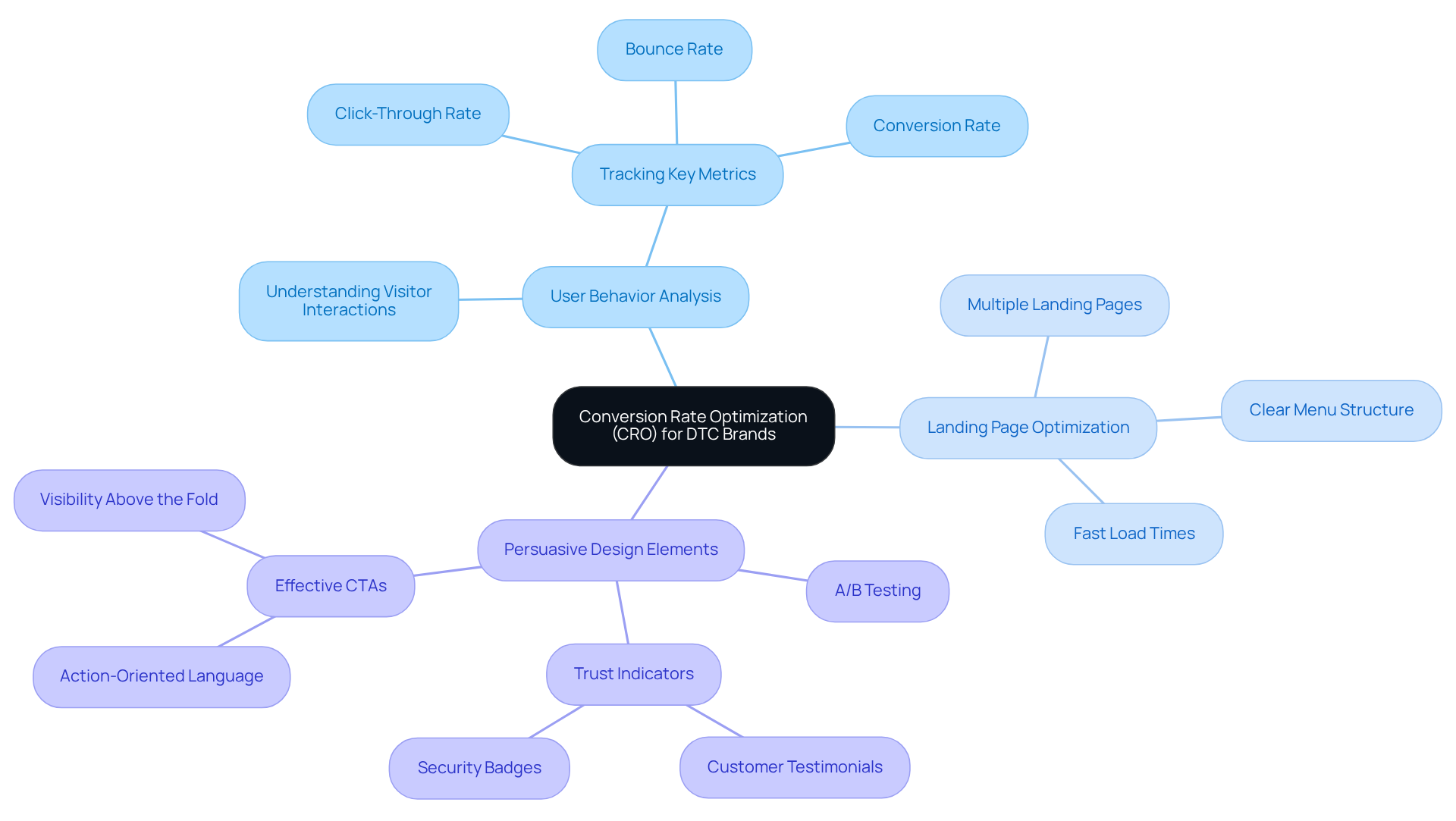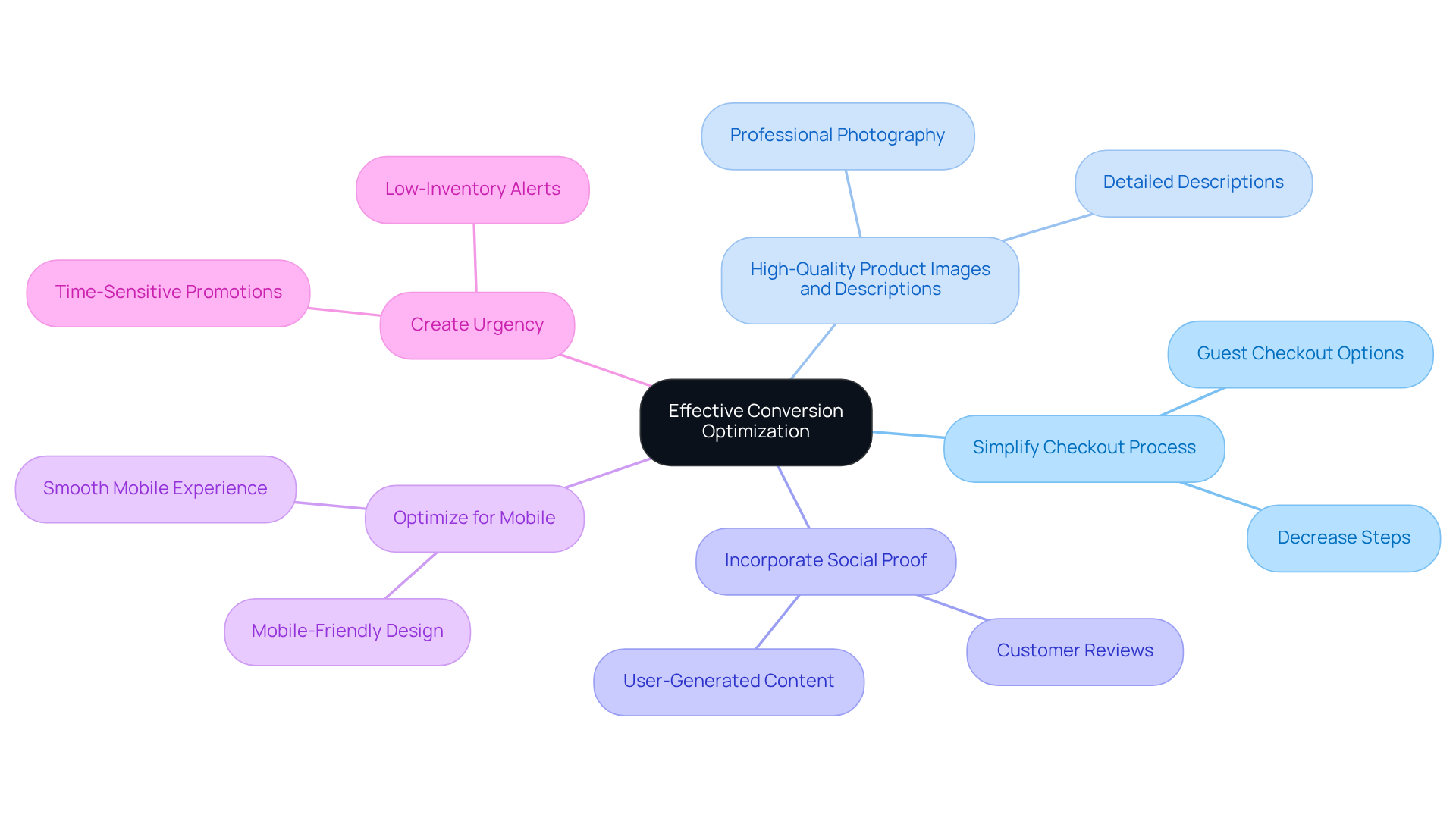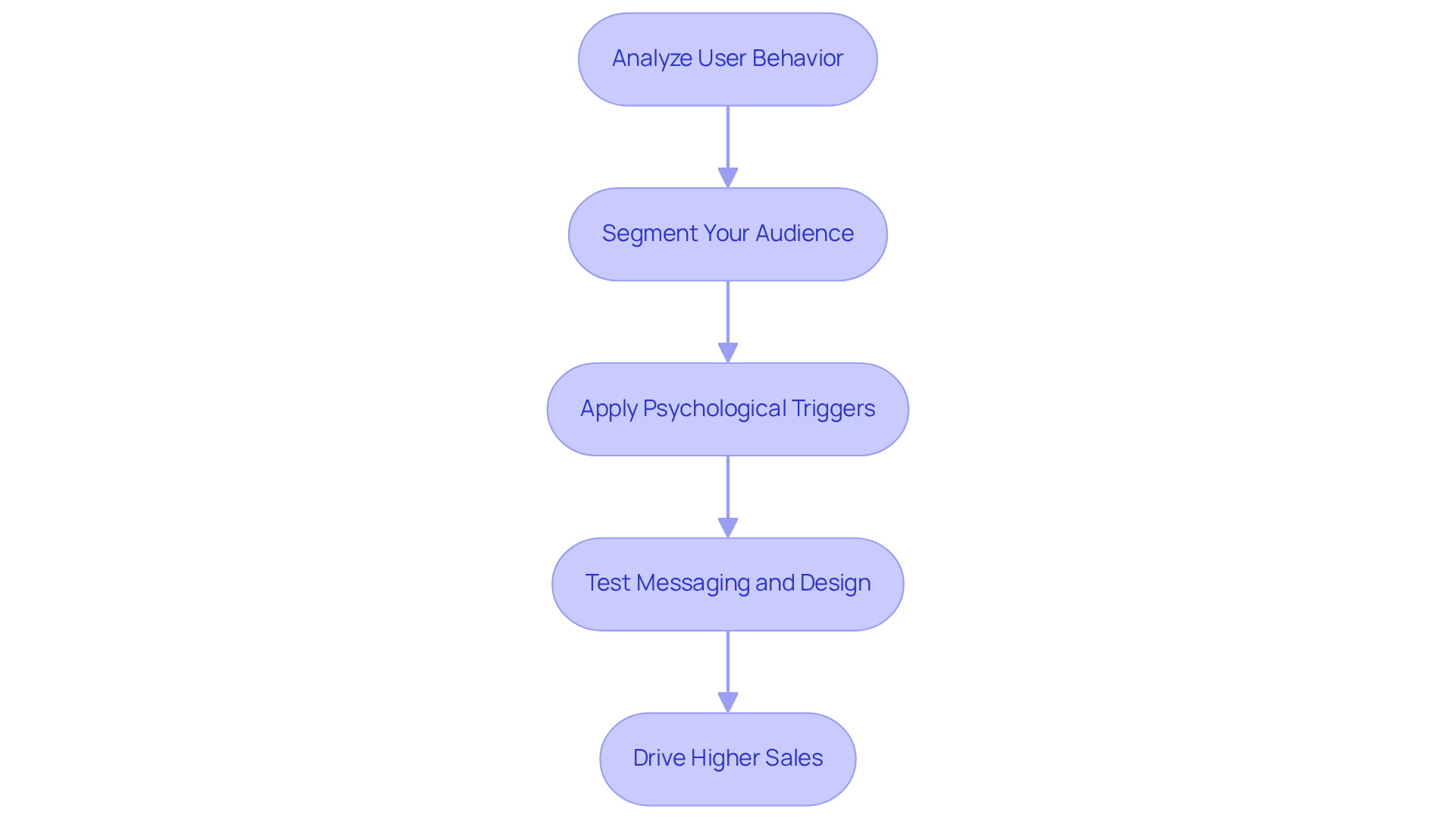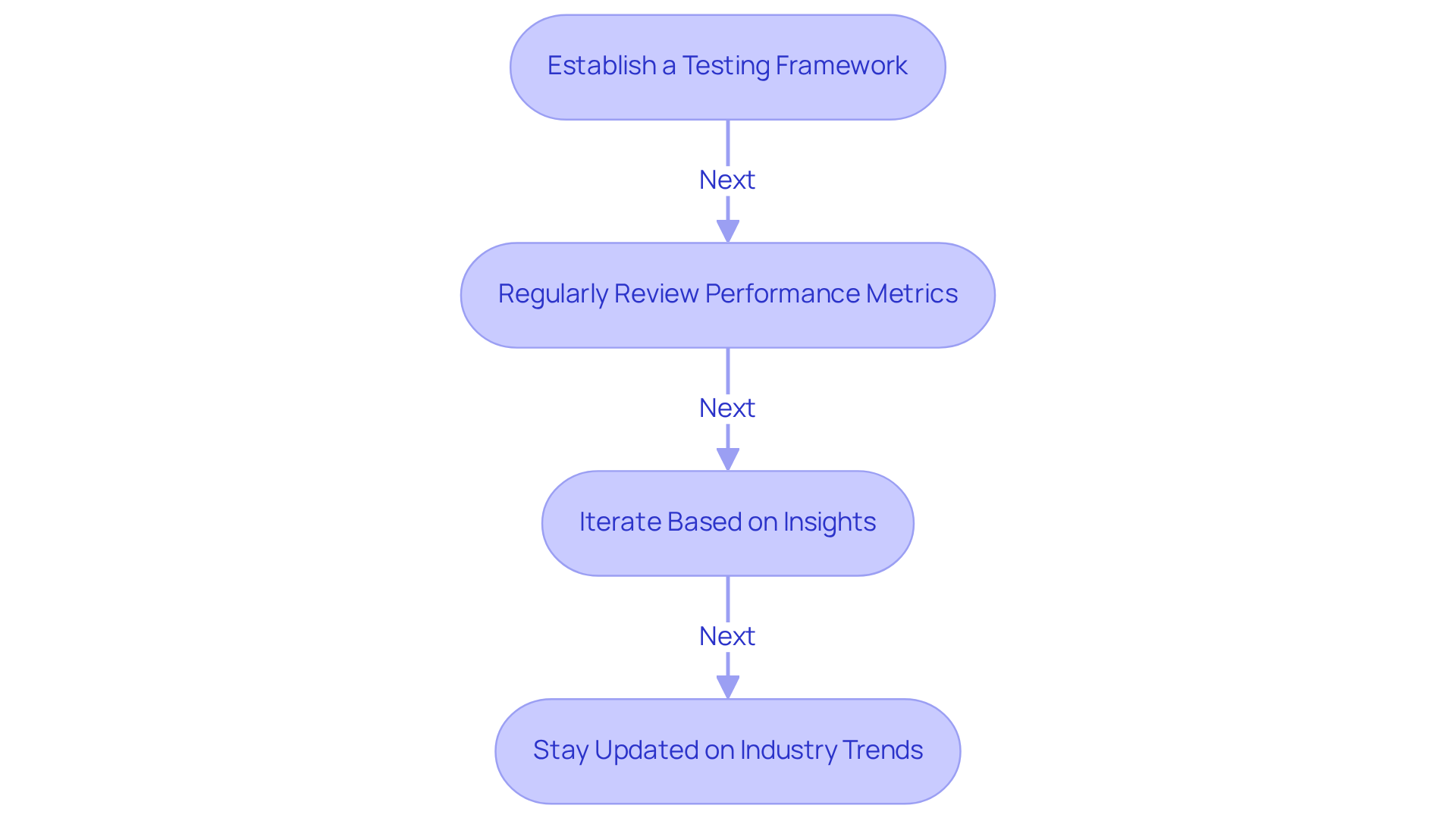
Overview
Mastering conversion optimization is essential for the success of direct-to-consumer (DTC) websites, as it significantly boosts the percentage of visitors who complete desired actions, such as making purchases. This article underscores the importance of this mastery by detailing key strategies. These include:
- Simplifying the checkout process
- Utilizing high-quality visuals
- Employing data-driven insights
Each of these strategies is designed to enhance user experience and ultimately drive substantial sales growth.
Introduction
Mastering the art of Conversion Rate Optimization (CRO) stands as a pivotal strategy for direct-to-consumer (DTC) brands seeking success in an increasingly competitive marketplace. With customer acquisition costs on the rise, the ability to convert existing website traffic into sales transcends mere benefit—it's essential for sustainable growth. This article explores proven strategies and psychological insights designed to empower DTC companies in enhancing their conversion rates.
However, what occurs when traditional methods fall short? How can brands innovate to maintain their edge in the ever-evolving e-commerce landscape?
Understand Conversion Rate Optimization (CRO) for DTC Brands
Understand Conversion Rate Optimization (CRO) for DTC Brands
Conversion Rate Optimization (CRO) is a strategic approach aimed at increasing the percentage of website visitors who complete desired actions, such as making purchases or signing up for newsletters. For direct-to-consumer (DTC) companies, effective CRO is essential in 2025, especially considering the rising costs of customer acquisition and the necessity to maximize the value obtained from existing traffic. By mastering CRO principles, companies can identify bottlenecks within their sales funnels, enhance user experiences, and ultimately achieve higher rates of success.
Key components of CRO include:
- Thorough analysis of user behavior: Understanding how visitors interact with your site to identify areas for improvement.
- Optimization of landing pages: Ensuring that landing pages are designed to convert visitors effectively.
- Implementation of persuasive design elements: Utilizing design strategies that resonate with target audiences.
For instance, companies can leverage A/B testing to refine their calls to action (CTAs) and enhance overall site usability. Furthermore, integrating trust indicators, like customer testimonials and security badges, can greatly improve credibility and promote transactions.
In 2025, the significance of CRO cannot be overstated; it not only enhances return on investment (ROI) but also allows DTC companies to flourish without the necessity for higher advertising costs. As industry leaders highlight, a well-implemented CRO strategy is essential for optimizing website results and ensuring sustainable growth in a competitive marketplace.
Why Partner with Parah Group?
- Onboarding Process: Once you sign on, you will have an onboarding call with your CRO lead to lay the foundation for long-term growth.
- Qualifications: We require companies to have a minimum of 100,000 website visitors and 2,000 conversions per month to ensure effective testing.
- Tailored Involvement: You can choose your level of involvement, as we customize our strategy and communication to fit your needs.
By concentrating on these areas, DTC companies can significantly enhance their return on investment (ROI) without raising their advertising expenditure. Parah Group's method nurtures a culture of innovation, promoting experimentation with new strategies and ongoing learning, which is vital for DTC companies to prosper without the necessity for higher advertising costs, ultimately resulting in improved profitability and growth.

Implement Proven Strategies for Effective Conversion Optimization
To effectively optimize conversion rates, DTC brands must implement several proven strategies that leverage a holistic approach to Conversion Rate Optimization (CRO) and emphasize the high ROI potential of these efforts:
- Simplify the Checkout Process: A complicated checkout can lead to cart abandonment. Optimizing this procedure by decreasing the number of steps and providing guest checkout alternatives significantly enhances success rates.
- Utilize High-Quality Product Images and Descriptions: Visual appeal is critical in e-commerce. Brands should invest in professional photography and detailed product descriptions that highlight benefits and features, ensuring they resonate with consumer psychology.
- Incorporate Social Proof: Displaying customer reviews, testimonials, and user-generated content builds trust and encourages new visitors to make a purchase. This aligns with the understanding that social validation can improve success metrics.
- Optimize for Mobile: With a growing number of consumers shopping on mobile devices, ensuring that websites are mobile-friendly is essential for capturing this audience. A smooth mobile experience can greatly influence sales outcomes.
- Create Urgency: Employing strategies like time-sensitive promotions or low-inventory alerts motivates customers to take action swiftly, enhancing sales performance. This strategy effectively taps into consumer psychology by creating a sense of urgency.
By implementing these strategies, along with a commitment to high-speed, thorough testing and coordination of marketing efforts, DTC companies can develop a conversion optimization website that provides a more engaging and effective online shopping experience, ultimately boosting sales and enhancing profitability over the long term.

Leverage Data and Consumer Psychology to Drive Conversions
Utilizing data and is essential for DTC companies aiming to elevate their conversion rates through a conversion optimization website. To achieve this, consider the following best practices:
- Analyze User Behavior: Employ tools such as heatmaps and session recordings to gain insights into user interactions on your site. This information uncovers pain points and highlights areas for improvement, enabling companies to refine their online experience.
- Segment Your Audience: By analyzing customer data, companies can categorize their audience based on behavior, preferences, and demographics. This segmentation facilitates tailored marketing strategies that resonate more effectively with distinct customer segments, enhancing engagement and increasing the likelihood of transactions.
- Apply Psychological Triggers: Techniques like scarcity (limited availability) and reciprocity (offering something for free) can significantly motivate customers to complete their purchases. A deep understanding of cognitive biases allows companies to craft persuasive messages that drive action and enhance sales.
- Test Messaging and Design: Implement A/B testing for various headlines, calls to action, and layouts to determine what resonates best with your audience. Data-driven adjustments can lead to substantial improvements in performance metrics, ensuring that marketing initiatives align with consumer preferences.
By integrating these practices, DTC companies can develop a conversion optimization website that fosters a more engaging and personalized shopping experience, ultimately driving higher sales.

Adopt Continuous Testing and Iteration for Long-Term Success
For DTC companies aiming for long-term success, a conversion optimization website that cultivates a culture of ongoing testing and iteration is essential. Implementing the following key practices can drive this initiative:
- Establish a Testing Framework: Develop a structured approach to testing that encompasses defining hypotheses, selecting relevant metrics, and determining appropriate sample sizes. This framework guarantees that tests yield statistically valid and actionable insights.
- Regularly Review Performance Metrics: Continuously monitor key performance indicators (KPIs) such as conversion rates, bounce rates, and average order values. Regular evaluations of these metrics on a conversion optimization website facilitate the recognition of trends and highlight areas needing focus, enabling companies to make data-driven choices.
- Iterate Based on Insights: Utilize the to guide decisions regarding website modifications. Iteration should be informed by the insights gained, allowing companies to refine their strategies and enhance user experience over time on their conversion optimization website.
- Stay Updated on Industry Trends: The e-commerce landscape is perpetually evolving. Staying informed about emerging technologies, shifting consumer preferences, and market trends is vital for adapting testing strategies and maintaining a competitive edge.
By committing to a process of continuous testing and iteration, DTC brands can effectively respond to changes in consumer behavior and market dynamics, ensuring sustained growth and improved conversion rates.

Conclusion
Mastering Conversion Rate Optimization (CRO) is paramount for the success of direct-to-consumer (DTC) brands. By concentrating on enhancing the percentage of visitors who complete desired actions, companies can significantly elevate their sales performance and customer engagement without incurring higher advertising costs. The effective implementation of CRO strategies not only fosters increased profitability but also positions brands advantageously in a competitive marketplace.
This article has discussed several key strategies for optimizing conversion rates. These strategies encompass:
- Simplifying the checkout process
- Utilizing high-quality product visuals
- Incorporating social proof
- Optimizing for mobile
- Creating a sense of urgency
Furthermore, leveraging data and consumer psychology through user behavior analysis, audience segmentation, and A/B testing can lead to more tailored marketing efforts that resonate with target audiences. The emphasis on continuous testing and iteration ensures that DTC companies can adeptly adapt to shifting consumer preferences and market dynamics.
In conclusion, the significance of conversion optimization for DTC brands is undeniable. As the e-commerce landscape continues to evolve, companies must adopt a proactive approach to CRO, embracing innovative strategies and nurturing a culture of ongoing improvement. By doing so, DTC brands can not only enhance their conversion rates but also secure sustainable growth and long-term success in an increasingly competitive environment. Engaging with these best practices will empower brands to make data-driven decisions that resonate with consumers, ultimately leading to increased sales and customer loyalty.
Frequently Asked Questions
What is Conversion Rate Optimization (CRO)?
Conversion Rate Optimization (CRO) is a strategic approach aimed at increasing the percentage of website visitors who complete desired actions, such as making purchases or signing up for newsletters.
Why is CRO important for direct-to-consumer (DTC) brands in 2025?
Effective CRO is essential for DTC brands due to rising customer acquisition costs and the need to maximize the value obtained from existing traffic. It helps identify bottlenecks in sales funnels and enhances user experiences.
What are the key components of CRO?
Key components of CRO include thorough analysis of user behavior, optimization of landing pages, and implementation of persuasive design elements.
How can companies use A/B testing in their CRO strategy?
Companies can leverage A/B testing to refine their calls to action (CTAs) and enhance overall site usability, leading to improved conversion rates.
What role do trust indicators play in CRO?
Trust indicators, such as customer testimonials and security badges, can greatly improve credibility and promote transactions on a website.
What qualifications does Parah Group require to partner with DTC brands?
Parah Group requires companies to have a minimum of 100,000 website visitors and 2,000 conversions per month to ensure effective testing.
How does Parah Group tailor its involvement with DTC companies?
Parah Group allows companies to choose their level of involvement, customizing their strategy and communication to fit the specific needs of the brand.
What benefits does a well-implemented CRO strategy provide for DTC companies?
A well-implemented CRO strategy enhances return on investment (ROI), promotes sustainable growth, and allows companies to improve profitability without increasing advertising costs.
FAQs











